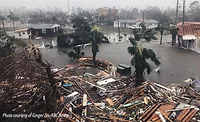More than $103 billion in economic losses due to natural disasters in 2019

In 2019, 396 natural disasters were recorded in EM-DAT with 11,755 deaths, 95 million people affected and $103 billion in economic losses across the world, according to Natural Disasters 2019, a new report by the Centre for Research on the Epidemiology of Disasters, The Université Catholique de Louvain and the U.S. Agency for International Development (USAID).
The burden was not shared equally as Asia suffered the highest impact and accounted for 40 percent of disaster events, 45 percent of deaths and 74 percent of the total affected. India was hit hardest and recorded nearly 20 percent of the total deaths and 24.5 percent of the total number of people affected. Floods were the deadliest type of disaster accounting for 43.5 percent of deaths, followed by extreme temperatures at 25 percent (mainly due to heat waves in Europe) and storms at 21.5 percent. Storms affected the highest number of people, accounting for 35 percent of the total affected, followed by floods with 33 percent and droughts with 31 percent.
In comparison to the previous decade (2009-2018), in 2019 there were more disasters compared to the annual average of 343 events, fewer deaths compared to the annual average of 45,212, fewer number of people affected compared to the annual average of 184.7 million people, and lower economic losses compared to the annual average of $176 billion. This decrease in impact is due to the absence of massive disaster events such as the 2010 earthquake in Haiti (222,500 deaths); the 2015 /2016 drought in India (330 million people affected); and the 2011 Japan earthquake and tsunami ($210 billion in damages).
The deadliest events recorded in 2019 were the summer heat waves that affected Europe, more specifically France, Belgium and the Netherlands, with over 2500 deaths.2 The National Oceanic and Atmospheric Administration (NOAA) ranked 2019 as the second warmest year on record.
Temperature records were also shattered on individual country levels: for the first time, Belgium and the Netherlands recorded temperatures over 40°C. In general, the impact of heat waves remains grossly underestimated. This is primarily due to underreporting in developing countries, where temperatures often exceed European values by a large margin and local populations have limited possibilities to protect themselves from heat wave exposure.
The following most deadly event consisted of the flood in India due to the high monsoon rains, which lasted from July to October and affected 13 states (mainly in the North) and caused nearly 2000 dead. Two storms were the next deadliest: cyclone Idai affected central Mozambique and Zimbabwe (March) with over 1200 deaths /missing; and storm Dorian affected the United States and the Bahamas in September with at least 358 deaths /missing. We recorded more than twice as many floods (194) as storms (91) this year, both types affecting nearly 64 million people worldwide. The African continent was particularly affected by storms in 2019: 11 recorded events accounted for a total of 1300 deaths and affected over 4.5 million people. One month after cyclone Idai, Mozambique was hit by another cyclone in the north, Kenneth, which is considered to be the strongest cyclone to ever hit the African continent.
Additional findings include:
- Cyclone Kenneth’s official death toll was much lower than Idai’s, with only 45 fatalities reported; nevertheless, the cyclone left nearly 400,000 people in need of humanitarian assistance in a country still struggling from the previous disaster.
- The deadliest geophysical event was the earthquake that hit Albania in November, and which killed 51 people.
- There was only one volcanic eruption with a deadly impact in 2019, namely the White Island eruption in New Zealand in December. This event was broadly covered by the media.
The year was also marked by large wildfires around the world which caught the public’s attention. The total damage and economic cost should reached 30 billion US$ in 2019. This estimate is likely to change in the future once there is more precise insight on the exact impact. At least 14 wildfires started in 2019, of which the most important were:
- California/USA (Kincade, Saddleridge and Sandalwood fires, October) with low human impact reported but with total damages estimated at 1.3 billion US$;
- Multi country event in South America/Amazonia for which it is quite difficult to have realistic figures on the human impact and the causal factors (both human and natural).
- Australia (September 2019 to February 2020): these long lasting wildfires led to 32 deaths, burned over 6 million hectares of forest and bush, killed almost 500 million animals, destroyed thousands of homes and forced hundreds of thousands of people to evacuate.
Overall, the most notable features of the year included: large, severe and long-lasting wildfires which captured international attention and had dramatic impacts on the environment, even if the human impact was less severe than in previous years, and multiple heat waves during summer time with record temperatures in several European countries.
Looking for a reprint of this article?
From high-res PDFs to custom plaques, order your copy today!







